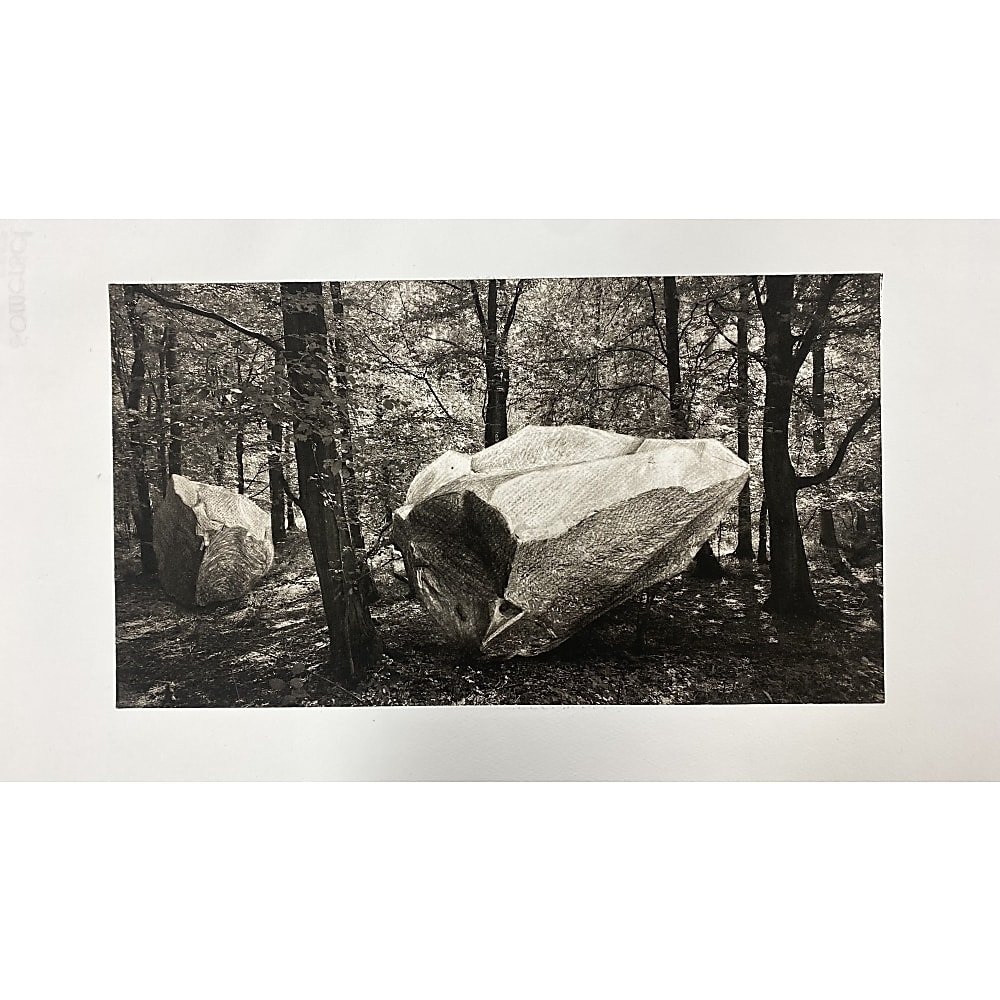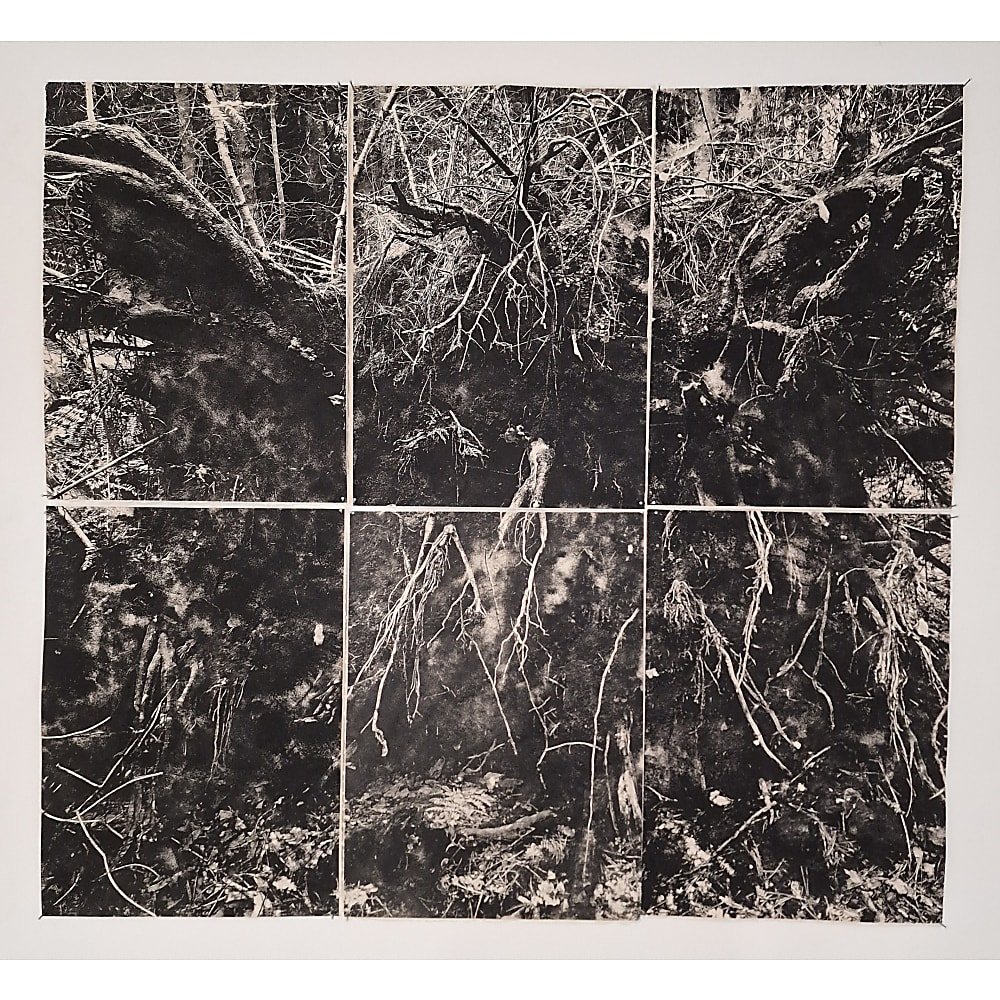Joe Dean
£0.00
Joe Dean’s recent work focuses on the rich geology and history of seemingly ordinary but vividly recalled places. He begins with photos, or film captured with a mobile phone, often recorded instinctively and without prior planning. He explores the way we respond to a place after we’ve left it behind, rather than remaining true to what is seen or recorded in the moment.
Dean will often collect objects and artefacts when revisiting these landscapes, like flint, or the lumps of chalk that fall from the cliff faces at his local chalk pit that have inspired recent drawings, photopolymer, and woodcut prints. He explores these sculptural forms through observational drawing and then gradually this evolves into printmaking.
Altered scale and incongruous juxtapositions evolve as the images take shape. They become an abstracted view of the original reality, a way of holding onto a fragment or feeling, making it concrete. The results are open to multiple readings and interpretations. Transitory moments are filtered and abstracted, and time is frozen or expanded to allow for further contemplation of what might seem unknown, insignificant, or inconsequential. There is a surreal or uncanny edge to the imagery but also a photographic quality that is retained.
Dean will often collect objects and artefacts when revisiting these landscapes, like flint, or the lumps of chalk that fall from the cliff faces at his local chalk pit that have inspired recent drawings, photopolymer, and woodcut prints. He explores these sculptural forms through observational drawing and then gradually this evolves into printmaking.
Altered scale and incongruous juxtapositions evolve as the images take shape. They become an abstracted view of the original reality, a way of holding onto a fragment or feeling, making it concrete. The results are open to multiple readings and interpretations. Transitory moments are filtered and abstracted, and time is frozen or expanded to allow for further contemplation of what might seem unknown, insignificant, or inconsequential. There is a surreal or uncanny edge to the imagery but also a photographic quality that is retained.
Joe Dean’s recent work focuses on the rich geology and history of seemingly ordinary but vividly recalled places. He begins with photos, or film captured with a mobile phone, often recorded instinctively and without prior planning. He explores the way we respond to a place after we’ve left it behind, rather than remaining true to what is seen or recorded in the moment.
Dean will often collect objects and artefacts when revisiting these landscapes, like flint, or the lumps of chalk that fall from the cliff faces at his local chalk pit that have inspired recent drawings, photopolymer, and woodcut prints. He explores these sculptural forms through observational drawing and then gradually this evolves into printmaking.
Altered scale and incongruous juxtapositions evolve as the images take shape. They become an abstracted view of the original reality, a way of holding onto a fragment or feeling, making it concrete. The results are open to multiple readings and interpretations. Transitory moments are filtered and abstracted, and time is frozen or expanded to allow for further contemplation of what might seem unknown, insignificant, or inconsequential. There is a surreal or uncanny edge to the imagery but also a photographic quality that is retained.
Dean will often collect objects and artefacts when revisiting these landscapes, like flint, or the lumps of chalk that fall from the cliff faces at his local chalk pit that have inspired recent drawings, photopolymer, and woodcut prints. He explores these sculptural forms through observational drawing and then gradually this evolves into printmaking.
Altered scale and incongruous juxtapositions evolve as the images take shape. They become an abstracted view of the original reality, a way of holding onto a fragment or feeling, making it concrete. The results are open to multiple readings and interpretations. Transitory moments are filtered and abstracted, and time is frozen or expanded to allow for further contemplation of what might seem unknown, insignificant, or inconsequential. There is a surreal or uncanny edge to the imagery but also a photographic quality that is retained.
Joe Dean’s recent work focuses on the rich geology and history of seemingly ordinary but vividly recalled places. He begins with photos, or film captured with a mobile phone, often recorded instinctively and without prior planning. He explores the way we respond to a place after we’ve left it behind, rather than remaining true to what is seen or recorded in the moment.
Dean will often collect objects and artefacts when revisiting these landscapes, like flint, or the lumps of chalk that fall from the cliff faces at his local chalk pit that have inspired recent drawings, photopolymer, and woodcut prints. He explores these sculptural forms through observational drawing and then gradually this evolves into printmaking.
Altered scale and incongruous juxtapositions evolve as the images take shape. They become an abstracted view of the original reality, a way of holding onto a fragment or feeling, making it concrete. The results are open to multiple readings and interpretations. Transitory moments are filtered and abstracted, and time is frozen or expanded to allow for further contemplation of what might seem unknown, insignificant, or inconsequential. There is a surreal or uncanny edge to the imagery but also a photographic quality that is retained.
Dean will often collect objects and artefacts when revisiting these landscapes, like flint, or the lumps of chalk that fall from the cliff faces at his local chalk pit that have inspired recent drawings, photopolymer, and woodcut prints. He explores these sculptural forms through observational drawing and then gradually this evolves into printmaking.
Altered scale and incongruous juxtapositions evolve as the images take shape. They become an abstracted view of the original reality, a way of holding onto a fragment or feeling, making it concrete. The results are open to multiple readings and interpretations. Transitory moments are filtered and abstracted, and time is frozen or expanded to allow for further contemplation of what might seem unknown, insignificant, or inconsequential. There is a surreal or uncanny edge to the imagery but also a photographic quality that is retained.





